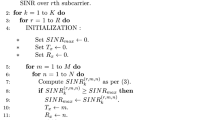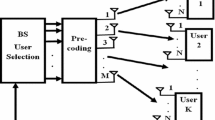Abstract
In this paper, authors propose novel limited feedback scheduling algorithms for multiple-input multiple-output (MIMO) orthogonal frequency division multiplexing (OFDM) broadcast channels (BC). Users feed back the maximum signal-to-interference-plus-noise ratio (SINR) and the index of the corresponding transmit antenna to base station. Here, it is proposed that a given user transmits back the maximum SINRs corresponding to each transmit antenna. It is shown that by this process the overall throughput improves significantly with comparatively small increase in feedback overhead (FO). Further, FO increases linearly with number of sub-carriers used in MIMO–OFDM. Adjacent sub-carriers experience similar channel conditions. Hence, they are grouped into clusters to reduce FO. Moreover, we propose that feedback of each user should consist of sum of the logarithmic values of the maximum SINRs corresponding to each transmit antenna for all sub-carriers present in a given cluster. The logarithmic based algorithm below a specific cluster size attains system sum-rate comparable to scheduling algorithms without sub-carrier grouping but with a reduction in FO by a factor equal to cluster size.














Similar content being viewed by others
Data Availability
Not applicable.
Code Availability
Not applicable.
References
Telatar, E. (1999). Capacity of multi-antenna gaussian channels. European Transactions on Telecommunication, 10, 585–596.
Caire, G., & Shamai, S. (2003). On the achievable throughput of a multiantenna gaussian broadcast channel. IEEE Transactions on Information Theory, 43, 1691–1706.
Viswanath, P., & Tse, D. N. (2003). Sum capacity of the vector gaussian broadcast channel and downlink-uplink duality. IEEE Transactions on Information Theory, 49, 1912–1921.
Weingarten, H., Steinberg, Y., & Shamai, S. (2004). The capacity region of the gaussian MIMO broadcast channel. In Proceedings of the IEEE International Symposium on Information Theory, Chicago, IL, USA, June 27–July 2, (p. 174).
Sharif, M., & Hassibi, B. (2005). On the capacity of MIMO broadcast channels with partial side information. IEEE Transactions on Information Theory, 51, 506–522.
Peng, Y., Armour, S., & McGeeham, J. (2007). An investigation of dynamic subcarrier allocation in MIMO-OFDMA systems. IEEE Transactions on Vehicular Technology, 56, 2990–3005.
Xiong, X., Jiang, B., Gao, X., & You, X. (2015). Qos guaranteed user scheduling and pilot assignment for large-scale MIMO-OFDM systems. IEEE Transactions on Vehicular Technology, 65, 6275.
Pattanayak, P., Pandey, D., & Kumar, P. (2015). Error rate performance for multiuser scheduling in MIMO downlink system with imperfect CSI. In Proceedings of the IEEE 5th International Conference on Wireless Communications, Vehicular Technology, Information Theory and Aerospace & Electronic Systems, December 2015.
Pattanayak, P., & Kumar, P. (2016). SINR based limited feedback scheduling for MIMO-OFDM heterogeneous broadcast networks. In Proceedings of the IEEE Twenty Second National Conference on Communication (NCC), March 2016.
Zhang, W., & Letaief, K. (2007). MIMO broadcast scheduling with limited feedback. IEEE Journal on Selected Areas in Communications, 25, 1457–1467.
Pattanayak, P., Roy, K. M., & Kumar, P. (2015). Analysis of a new MIMO broadcast channel limited feedback scheduling algorithm with user grouping. Wireless Personal Communications, 80, 1079–1094.
Xu, W., & Zhao, C. (2010). Two-phase multiuser scheduling for multiantenna downlinks exploiting reduced finite-rate feedback. IEEE Transactions on Vehicular Technology, 59, 1367–1380.
Pattanayak, P., & Kumar, P. (2016). Quantized feedback MIMO scheduling for heterogeneous broadcast networks. Wireless Networks, 23, 1449.
Fakhereddin, M., Sharif, M., & Hassibi, B. (2009). Reduced feedback and random beamforming for OFDM MIMO broadcast channels. IEEE Transactions on Communications, 57, 3827–3835.
Pattanayak, P. (2020). Two-bit SINR quantization based scheduling scheme for MIMO communications. In 2020 Advanced Communication Technologies and Signal Processing (ACTS) (pp. 1–6).
Eslami, M., & Krzymien, W. A. (2011). Net throughput maximization of per-chunk user scheduling for MIMO-OFDM downlink. IEEE Transactions on Vehicular Technology, 60, 4338–4348.
Pattanayak, P., & Kumar, P. (2015). Limited feedback scheduling for MIMO-OFDM broadcast network. In Proceedings of the 18th IEEE International Symposium on Wireless Personal Multimedia Communications, Hyderabad, India, 13–16 Dec. 2015.
Pattanayak, P., & Kumar, P. (2019). An efficient scheduling scheme for MIMO-OFDM broadcast networks. AEU - International Journal of Electronics and Communications, 101, 15–26.
Svedman, P., Wilson, S., Cimini, L., & Ottersten, B. (2004). A simplified opportunistic feedback and scheduling scheme for OFDM. In Proceedings of the IEEE Vehicular Technology Conference (pp. 1878–1882).
Pattanayak, P., & Kumar, P. (2018). Combined user and antenna scheduling scheme for MIMO-OFDM networks. Telecommunication Systems. https://doi.org/10.1007/s11235-018-0462-0
Svedman, P., Wilson, S., Cimini, L., & Ottersten, B. (2007). Opportunistic beamforming and scheduling for ofdma systems. IEEE Transactions on Communications, 55, 941–952.
Pattanayak, P., & Kumar, P. (2017). Quantized feedback scheduling for MIMO-OFDM broadcast networks with subcarrier clustering. Ad Hoc Networks, 65, 26–37.
Tomasin, S. H., Alizadeh, S. T., & Shojafar, M. (2017). Cluster-head based feedback for simplified time reversal prefiltering in ultra-wideband systems. Physical Communication, 25, 100–109.
Naeem, M., & Lee, D. (2011). Low-complexity joint transmit and receive antenna selection for MIMO systems. Engineering Applications of Artificial Intelligence, 24, 1046–1051.
Pattanayak, P., Sarmah, D., Mishra, S., & Panda, A. (2021). Computationally efficient scheduling methods for MIMO uplink networks. Soft Computing, 25, 11763.
Naeem, M., & Lee, D. (2014). A joint antenna and user selection scheme for multiuser MIMO system. Applied Soft Computing, 23, 366–374.
Pattanayak, P., & Kumar, P. (2015). A computationally efficient genetic algorithm for MIMO broadcast scheduling. Applied Soft Computing, 37, 545–553.
Pattanayak, P., & Kumar, P. (2020). Computationally efficient scheduling schemes for multiple antenna systems using evolutionary algorithms and swarm optimization. In A. H. Gandomi, A. Emrouznejad, M. M. Jamshidi, K. Deb, & I. Rahimi (Eds.), Evolutionary computation in scheduling (Vol. 5, pp. 105–135). Wiley.
Mohanty, J., Pattanayak, P., Nandi, A., Baishnab, K. L., Gurjar, D. S., & Mandloi, M. (2021). MIMO broadcast scheduling using binary spider monkey optimization algorithm. Wiley International Journal of Communication Systems, 34, e4975.
Mohanty, J., Pattanayak, P., Nandi, A., Baishnab, K. L., & Talukdar, F. A. (2021). Binary flower pollination algorithm based user scheduling for multiuser MIMO systems. Turkish Journal of Electrical Engineering & Computer Sciences (accepted). https://doi.org/10.3906/elk-2109-21.
Pattanayak, P., Sarmah, D., & Paritosh, P. (2020). Low complexity based scheduling methods for multi-user MIMO systems. Elsevier Physical Communication, 43, 101192.
Pattanayak, P. (2020). Subcarrier wise scheduling methods for multi-antenna and multi-carrier systems. Wireless Personal Communications, 114, 1485.
Tse, D., & Viswanath, P. (2005). Fundamentals of wireless communication. Cambridge University Press.
Pattanayak, P., Trivedi, V. K., Chakraborty, S., Kumar, P. (2017). BER performance of multi user scheduling for MIMO-STBC and MIMO-OFDM broadcast network with imperfect CSI. In 2017 4th International Conference on Signal Processing and Integrated Networks (SPIN), Feb 2017 (pp. 66–70).
Funding
This work was supported by the Ministry of Electronics & Information Technology (MeitY), Govt. of India (GoI) under a research Grant No: R-23011/3/2020-R&D in CC&BT.
Author information
Authors and Affiliations
Corresponding author
Ethics declarations
Conflict of interest
This work does not have any conflict of interest/competing interests.
Additional information
Publisher's Note
Springer Nature remains neutral with regard to jurisdictional claims in published maps and institutional affiliations.
Rights and permissions
About this article
Cite this article
Pattanayak, P. Proficient User and Antenna Selection Strategies for Multi-carrier MIMO Communications Using Adjacent Sub-carrier Clustering. Wireless Pers Commun 125, 1221–1242 (2022). https://doi.org/10.1007/s11277-022-09598-x
Accepted:
Published:
Issue Date:
DOI: https://doi.org/10.1007/s11277-022-09598-x




